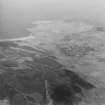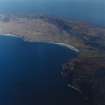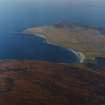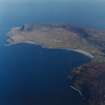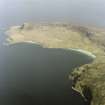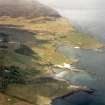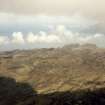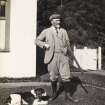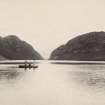Eigg, General
General View (Period Unassigned)
Site Name Eigg, General
Classification General View (Period Unassigned)
Canmore ID 106170
Site Number NM48NE 47
NGR NM 4600 8600
NGR Description Centred on NM 4600 8600
Datum OSGB36 - NGR
Permalink http://canmore.org.uk/site/106170
- Council Highland
- Parish Small Isles
- Former Region Highland
- Former District Lochaber
- Former County Inverness-shire
EIGG
If the story of the Gàidhealtachd can be told through the microcosm of individual islands, none succeeds more emotively than Eigg, visible from afar as a tilting, sharp-spined flank with guiding fin. Buildings and landscape chronicle turbulent chapters of Hebridean history, from settlement by Mesolithic hunter-fishermen and the vicissitudes of inter-clan rivalry, kelp harvesting and over-population, to the coming of sheep, wealthy sportsmen and 'white settlers'. Following the earliest occupants, Neolithic farmers and then Iron Age Celts colonised the island's fecund slopes, their legacy curious burial mounds and a series of coastal duns and stone wheelhouses. In the early 7th century, St. Donnan arrived by coracle with some zealous disciples and founded a monastery here. Norse domination has yielded a number of fabulous artefacts, of particular note an encrusted bronze sword hilt and a longship's stern (now in the National Museum of Scotland). Eigg's strategic location on the sea highway that was the nerve system of Garmoran made the island an important part of the 14 th century, inheritance of Ranald MacRuari, progenitor of Clanranald. A royal charter was granted, but feuds between the Clanranalds and their rivals persisted, culminating in the infamous suffocation of the island's population in a cave (Uamh Fhraing - Cave of St. Francis) by the Macleods of Harris and Skye in the 16th century. Eigg remained in Clanranald ownership until 1827/8 when, already plagued by evictions and emigration, it was sold to alleviate debts. Dr Hugh Macpherson, sub-principal of Kings College, Aberdeen, became the new owner, and during his and his descendants' absentee proprietorship the island suffered greatly from famine and widespread clearances. With its sale in 1896 to Robert Lawrence Thomson MacEwen (alias Robert Thomson, Far Eastern Times correspondent turned international arms dealer, who also owned Muck and Strathaird), Eigg saw the coming of the first of a new breed of island owner: the Edwardian magnate. Thomson carried out some improvements but sold in 1916 to the London ship owner, Sir William Petersen. Around 1925 another shipping tycoon and government minister, the improving and modernising sportsman Sir Walter Runciman, became laird and saw Eigg through a period of relative prosperity, during which the island enjoyed a harmony denied it in subsequent decades. In 1997, it was the subject of a much-publicised community buy-out, which established an incentive for other remote communities across the Highlands and Islands.
Taken from "Western Seaboard: An Illustrated Architectural Guide", by Mary Miers, 2008. Published by the Rutland Press http://www.rias.org.uk


































































































